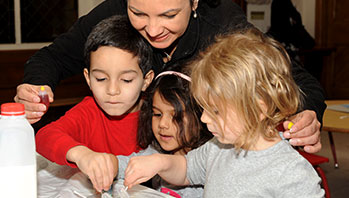- eyedroppers
- markers or crayons
- paper
- plexiglass sheet or plastic mirror
- water
- drip
- drop
- flow
MA Standards:
Language/L.PK.MA.6: Use words and phrases acquired through conversations, listening to books read aloud, activities, and play.
MA Draft STE Standards:
Earth and Space Sciences/Earth’s Systems/ESS2.A: Observe, investigate, and classify the non-living materials, natural and human made, in their environment.
Head Start Outcomes:
Logic and Reasoning/Reasoning and Problem Solving: Classifies, compares, and contrasts objects, events, and experiences.
Science Knowledge/Conceptual Knowledge of Natural and Physical Worlds: Observes, describes, and discusses properties of materials and transformation of substances.
PreK Learning Guidelines:
English Language Arts/Language 2: Participate actively in discussions, listen to the ideas of others, and ask and answer relevant questions.
Science and Technology/Physical Sciences 19: Explore, describe, and compare the properties of liquids and solids found in children's daily environment.
Small Group: Water Drop Races

© Commonwealth of Massachusetts, Department of Early Education and Care (Jennifer Waddell photographer). All rights reserved.
STEM Key Concepts: Water can flow quickly or slowly; Water in small amounts forms drops; Water drops stick together; Water behaves differently on different surfaces
ELA Focus Skills: Listening and Speaking, Vocabulary
- Have children use eyedroppers to put water drops on a smooth, vertical surface such as a sheet of plexiglass or a plastic mirror. Have them explore putting two drops on the surface and watching how the drops flow down the surface.
- Encourage children to squirt the water out and drip the water out to compare how the drops flow. Have children work with a partner to discuss ideas and share outcomes as they observe.
- Have children record their findings. Encourage them to think about how fast or slow the water flows, how the water sticks to itself, how the water behaves differently or the same on the smooth surface compared to the wax paper or construction paper from earlier observations.
